Urban
Interview students Ian Kazimer, Shawn Wilson, Kristoffer
Smith, and Shane Levin hard at work. Photo: Peter Burr
“
This year, we had six students make an homage
to (the late) Tupac Shakur, one of their favorite
rappers.
They made these really beautiful silkscreen
prints,” recalls Carrie Schneider, the
museum’s
youth programs coordinator. Director of Collections
and Research John Smith hung them between two
of Warhol’s
Guns prints. In that setting, their work became
a powerful statement
as well as a memorial.
Another student created an
installation piece with scavenged 1950s-era washing
machines, on which she
silkscreened ‘50s
advertisements. They looked right at home next
to Warhol’s
silkscreens of advertisements.
Teens seeking more
job-oriented forms of exploration also have a
place at The Warhol. Each year, as
part of The Warhol’s Urban Interview program,
a group of students produces their own version
of Warhol’s
Interview magazine. The Interview program, also
known as the After School Youth Technology program,
gives participants
opportunities to speak with people they find interesting.
Examples include Goosebumps author R.L. Stine,
Pittsburgh Mayor Tom Murphy, a video game programmer,
and a jewelry
designer.
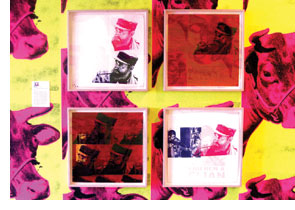 One Youth
Invasion 2004 youth artwork—created
through a partnership between Warhol's alma mater Schenley
High School and The Warhol—was hung on Warhol's
Cow Wallpaper.
One Youth
Invasion 2004 youth artwork—created
through a partnership between Warhol's alma mater Schenley
High School and The Warhol—was hung on Warhol's
Cow Wallpaper.
“
They’re able to interview anyone they
like,” says
Schneider. “Whatever their interests
are, we encourage them to pursue those.”
They
also learn the computer skills necessary to
produce the magazine. The students are actually
hired and paid
with funding from Youthworks, a Pittsburgh
organization that helps young adults build
job skills.
Whether they choose to take part
in Youth Invasion planning and activities or prefer
the world
of magazine production
offered by Urban Interview, both programs
lead these young adults to a greater understanding
of how art
integrates with the bigger picture of their
lives. “I think
these kids feel really comfortable here. And
that’s
a really big goal,” says Schneider. “They’re
beginning to feel like this is a place for
them.”
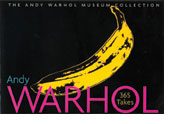 Piece by Piece
Piece by Piece
The Warhol staff reflect
on Warhol’s
work in a new souvenir book.
Trying to put together a souvenir book for visitors
to The Andy Warhol Museum was a daunting task. After
all, the authors had to find a way to squeeze into
a few hundred pages the life and work of a man whose
creative output can’t even be contained in one
museum.
To accomplish the goal, Director Thomas Sokolowski
and Director for Collections and Research John Smith
spent several days in a conference room with fellow
staffers,
sorting
through
images,
weighing words, trying to decide how to avoid the
common while not slipping into scholarly esoterica—seeking
to give a good overview and provide insights not
only to visitors, but also to knowledgeable fans. And
yes,
even to scholars.
“
We wanted the book to reflect not only the collection
of the museum but also the philosophy of the museum,” says
Smith. “In
our mission statement, we say we’re more than
a museum, so the book had to be more than a handbook.”
 Statue
of Liberty, 1986 © 2004 AWF
Statue
of Liberty, 1986 © 2004 AWF
Actually, Andy Warhol: 365 Takes: The Andy Warhol Museum
Collection, is more like a “brick”—the
publishing industry term for a book that’s
short, thick, and horizontal. The “365” comes
from the name of a museum-book series created by
publisher Harry N. Abrams Inc. It actually has 750
pages with
about 400 images, some of which have never before
been displayed. They include all facets of Warhol’s
art, from paintings to film, plus items from the
collection of “time capsule” boxes into
which he deposited bits and pieces of his life. The
visuals are accompanied
by Warhol’s own comments about his work, interspersed
with observations and insights by The Warhol staff.
“
We collaborated on this project, in a way, with
Warhol himself,” Smith says. “He
wrote this book.”
It includes biographical
information and descriptions of Warhol’s
work processes, but also, Smith says, tidbits
that convey his eccentricities: “The
kinds of things that ‘you wouldn’t
believe it if we told you, but . . . .’”
As
part of the book’s June 10 launch celebration,
a release party was held at the Ronald Feldman
Gallery in New York. The party also kicked
off a special Warhol
exhibition at the gallery, Takes and Outtakes
from The Andy Warhol Museum, which runs
through July 30.
Feldman was the main publisher of Warhol’s
prints from approximately 1980 until the artist’s
death in 1987.
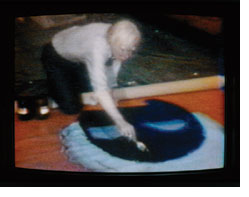 Factory
Diary: Andy Warhol Painting a Drag Queen,
1974 © 2004 The Andy Warhol Museum,
Pittsburgh
Factory
Diary: Andy Warhol Painting a Drag Queen,
1974 © 2004 The Andy Warhol Museum,
Pittsburgh
Feldman vividly recalls what
Warhol’s show-opening
soirees were like back then. “When Warhol
was alive, it was a block party. We never could
get everyone
into the gallery,” he says, noting the
current exhibition is filled with items that
represent Warhol’s
life—including some that Feldman personally
helped him to acquire.
“
We spent more time in flea markets and junky
antique shows than we did at museums,” Feldman
remembers. “He
was a total workaholic. He was a great shopper,
but he also was a shopper for ideas.” Smith
says the Feldman exhibit is intended to remind
New Yorkers
that the main repository of those ideas is
in Pittsburgh. Adds Feldman: “This
is great material. We wish we could see it
more often. The Warhol has turned out
to be a national treasure.”
Feldman can’t
believe anyone needs to be reminded of that.
But for those who require convincing, there’s
a “brick” that should do the trick.
A Fresh Look
at Warhol’s
Flowers
Collaboration with
Carnegie Mellon University’s
Hunt Botanical Institute helps The Andy Warhol Museum
examine the theme of flowers throughout art history.
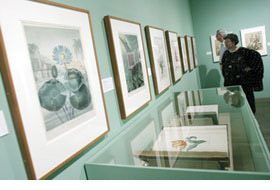 Visitors
enjoy several of the Hunt Institute’s botanical
prints during the opening event for Flowers Observed,
Flowers Transformed.
Visitors
enjoy several of the Hunt Institute’s botanical
prints during the opening event for Flowers Observed,
Flowers Transformed.
Andy Warhol might have spent many hours at Carnegie
Mellon University’s Hunt Institute for Botanical
Documentation if it had existed during his student
years. But the institute, originally named the Rachel
McMasters Miller Hunt Botanical Library, was formed
in 1961, 12 years after the flower-loving artist graduated.
Four
decades later, Warhol’s floral-themed work
and the institute’s vast collection of botanical
art have finally been intertwined, via The Andy Warhol
Museum exhibition, Flowers Observed, Flowers
Transformed.
The museum’s 10th anniversary exhibition includes
36 items from the institute’s extensive collection
of botanical art.
John Smith, The Warhol’s
director of collections and research, says the
idea grew out of an attempt
to take a fresh look at Warhol’s body of
work. The Warhol staff sought to examine themes
in his
creations and how themes throughout art history
found their way
into his art. The idea was to reassess him as part
of a continuum, an art historical narrative, so
to speak. According to Smith, Warhol’s work
has never been presented in this way. “We
wanted to show that Warhol was influenced and drew
heavily
from art history.” says Smith. “And
the results of Warhol’s interaction with
art history have in turn created more art history
that has permeated
contemporary art.”
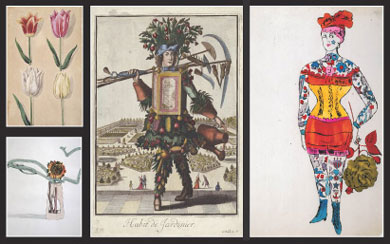
Clockwise
from top left:
Attributed to Johann Theodore de Bry (1561-1623 Germany).
© 2004 by Hunt Institute for Botanical Documentation,
Carnegie Mellon University.
Nicolas
de Larmessin, Habit de Jardinier, ca. 1690. © 2004
by Hunt Institute for Botanical Documentation, Carnegie
Mellon University.
Andy Warhol,
Tattooed Woman, ca. 1950s. © AWF
Andy Warhol, Flowers,
1974.
© AWF
From that, the concept
grew into using Warhol’s
floral work as a platform for an historic examination
of how flowers have been used, not only in the
art world, but also in botany, natural history,
the decorative
arts, and other areas. “Flowers seemed
the perfect theme to begin with because they
were a
principal motif
of Warhol’s from the ’50s until 1986,
a year before he died,” says Smith.
Finding
pieces of artwork that could help convey The
Warhol’s new approach was as easy as
revisiting Warhol’s old stomping grounds,
at Carnegie Mellon University. Hunt Institute,
known internationally in
academia but practically unheard of in its own
backyard, was filled with perfect examples from
its art department,
which holds more than 30,000 original paintings,
drawings,
and prints dating from the Renaissance to the
present. And the staff was happy to participate
in the exhibition. “Some
of the institute’s finest work is in the exhibition,” says
James J. White, curator of art and principal research
scholar at the institute.
“
The Warhol borrowed twice as many as we would ordinarily
show at any one time,” White adds, explaining
that half of the works will be shown during the first
part of the exhibition, then will be replaced by other
pieces during the second half because of concerns about
exposing the delicate paintings to too much light.
White promises there will be little difference in what
viewers will see, but adds, “They should just
come back again.”
Flower-Inspired Programs Expand Exhibition
As part of the Flowers Observed, Flowers Transformed exhibition, a series of related programs are planned
for the public. Every Saturday from 2-4 p.m., in
the 7th floor gallery, visitors will be invited to
join The Warhol’s artist/educators along with
poets, scholars, and garden experts for special flower-themed
demonstrations, informal talks, and discussions.
Floral teas and candies also will be served. All
programs are free with museum admission.
July 10
Doug Oster, Backyard Gardener columnist at the Pittsburgh
Post-Gazette, will give a talk entitled, Photographing
Your Garden.
July 17
Jan Beatty, poet, will present a flower-themed poetry
reading and Aimee McWherter-Compton and Regina Wilderman,
hair designers, will present a flower-inspired fashion
show.
July 24
Demonstrations of flower craft in Carpatho-Rusyn
culture, presented as part of the museum-wide 7th
Annual Carpatho-Rusyn
event, 12–4 p.m.
July 31
Cheryl Nashbar, Bach Flower Essence instructor, will
give a talk entitled, Warhol’s Flowers:
Were They Healing Him?
August 7
Elisabeth Agro, curator of decorative arts at Carnegie
Museum of Art, will give a talk entitled, Flowers
in Decorative Arts.
August 14
Laura Winter, garden educator and director of Green
Millennium Garden, will give a talk entitled, Eating
Your Flower Arrangement and Other Garden Delights.
August
21
Kathy McGregor, Sylvania Natives nursery director,
will give a talk entitled, Natives and Invasives:
Restoring Plants in Pennsylvania.
August 28
Amy Lamb, nature photographer and Ph.D. in biology,
will present a hands-on demonstration entitled, Botanical
Photography: Growing and Pressing Flowers.
September
4
May Beth Steisslinger of the Pittsburgh Parks Conservancy
will give a talk entitled, From Seeding to
Killing: A Day in the Life of a Restoration Biologist.
The exhibition Flowers Observed, Flowers Transformed
has been supported in part by The Roy A. Hunt Foundation.
Back to Contents